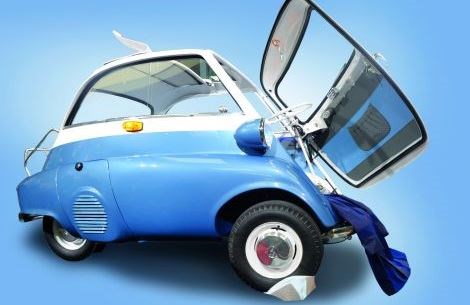MySetta's New Styling With Clever BASF Technologies
A specially developed two-tone finish was applied to the microcar at BASF Coatings’ Refinish Competence Center in Münster by experienced master spraypainter Michael Wichmann using blue for the lower part of the car and white for the top.

The BMW Isetta gets a new look with new painting technology.
Once named the “bubble car,” the BMW Isetta turns heads wherever it goes. It gets people’s creative juices flowing, and not just for thinking up nicknames. BASF has created a unique “MySetta” show car based on a 1958 BMW Isetta 250.
The MySetta is a two-seater that you enter through the front. Innovative BASF products were used to give the car a modern outfit. The MySetta’s chassis, the body, the add-on parts and its interior were completely refurbished. For the overhaul, BASF paints, coated fabrics and flexible foam were used.
BASF’s broad portfolio made this individual project possible. Whether for polyurethane foams for ergonomically correct seats, lightweight engine mounts made of plastic, or unusual coatings, BASF is the world’s largest automotive supplier in the chemical industry.
“The automotive industry is one of the BASF Group’s most important customer segments. In order to consolidate the activities and competencies, a lively exchange takes place in the cross-divisional teams,” said Harald Pflanzl, Head of Automotive Refinish Europe at BASF.
The MySetta made different stops during its refurbishment. For the first stop, a specially developed two-tone finish was applied to the microcar at BASF Coatings’ Refinish Competence Center in Münster. During the meticulous refinishing process, the experienced master spraypainter Michael Wichmann oriented himself toward the original color, using blue for the lower part of the car and white for the top.
The “motocoupe” now turns heads with its shimmering basecoat. The waterborne special-effect paint is composed of the colors Big White and the metallic blue Bluetta, which BASF color designers specially created for the Isetta. Special-effect materials create Big White’s brilliant appearance. The modern high-tech paints from BASF’s automotive refinish brand Glasurit 90 Line were used. For classic cars, Glasurit also has a dedicated portfolio: the Classic Car Colors, which features the world’s largest historic color library with a total of 600,000 mixing formulas. Of course, the collection also includes the Isetta’s original colors.
The MySetta’s interior was also redesigned. The seats and interior lining were furnished with an innovative new cover. It was produced with the Steron system solution, a special transfer coating technology for unique soft-touch surfaces with flexible and nearly limitless design options. The starting point for the production of this cover is a silicon matrix in which the desired surface structure is engraved with a laser. A polyurethane dispersion is sprayed as a thin coat into the matrix, similar to a mold, and takes on the desired form here.
By means of modern laser technology, the matrices can be produced quickly and less expensively, with individually created designs. The method can also be used on a wide variety of carrier substrates such as leather and textile, as well as paper and plastic. “In addition to the automotive sector, the Steron’s versatile properties and design options make it suitable for a whole range of applications, such as fashion, accessories, furniture and packaging,” explained Heidrun Goth, head of Steron development. Apart from MySetta, for example, the smart forvision, the concept car presented jointly with Daimler, was also outfitted with seat covers made of Steron.
Related Content
Masking Solutions for Medical Applications
According to Custom Fabricating and Supplies, a cleanroom is ideal for converting, die cutting, laminating, slitting, packaging and assembly of medical-grade products.
Read MoreTop Shop Builds Original Systems for Coating Medical Devices
Engineers at Surgical Coatings in Colorado have been ingeniously developing their own equipment, automation, processes and software since this powder coater’s inception in 1995.
Read MoreCan You Afford to Not Use Custom Masking?
Are you weighing the costs of a custom masking solution vs. an off-the-shelf solution? Christy Schulthess of Custom Fabricating & Supplies discusses the overall savings that can be realized with custom masking.
Read MorePowder Coater Leverages Its Manufacturing Mindset for Success
As a former motorcycle manufacturer, this powder coating Top Shop benefits from understanding the finishing industry from a customer’s perspective.
Read MoreRead Next
Delivering Increased Benefits to Greenhouse Films
Baystar's Borstar technology is helping customers deliver better, more reliable production methods to greenhouse agriculture.
Read MoreEpisode 45: An Interview with Chandler Mancuso, MacDermid Envio Solutions
Chandler Mancuso, technical director with MacDermid Envio discusses updating your wastewater treatment system and implementing materials recycling solutions to increase efficiencies, control costs and reduce environmental impact.
Read MoreA ‘Clean’ Agenda Offers Unique Presentations in Chicago
The 2024 Parts Cleaning Conference, co-located with the International Manufacturing Technology Show, includes presentations by several speakers who are new to the conference and topics that have not been covered in past editions of this event.
Read More





















